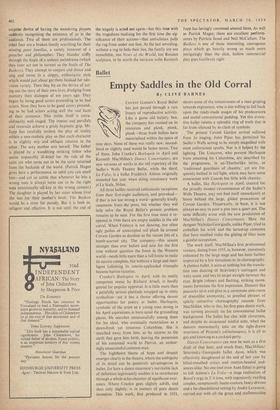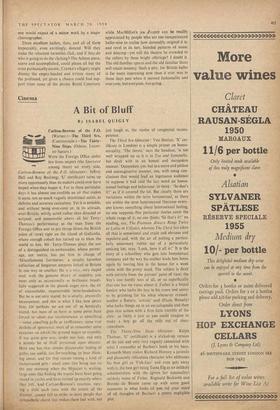Ballet
Empty Saddles in the Old Corral
By CLIVE BARNES,
COVEN' GARDEN'S Royal Ballet has just passed through a rare 'frenzy of reproductive activity. Like a game old battery hen, the company has roosted on its resources and plonk, plonk, plonk—three fresh ballets have materialised within the space of nine days. None of these was really new; second- hand or slightly used would be better terms. Two of them, John Cranko's Harlequin in April and Kenneth MacMillan's Danses Coneertantes, are new versions of works in the old repertory of the Sadler's Wells Theatre Ballet, while the third, La Valse, is a ballet Frederick Ashton originally mounted last year when doing missionary work at La Scala, Milan.
All three ballets received enthusiastic receptions from their first-night audiences, and provoked— if that is not too strong a word—generally kindly comments from the press, but whether they will help solve the Royal Ballet's present problem remains to be seen. For the first time since it re- opened in 1946 there are empty saddles in the old corral. When Fonteyn is not dancing, too often ugly gashes of unoccupied red plush lie around Covent Garden as desolate as the vacant lots of a bomb-scarred city. The company—this season stronger than ever before and now for the first time without question the finest in the Western world—needs little more than a full house to make its success complete, but without a large and intel- ligent following its coterie-applauded triumphs become barren victories.
Cranko's Harlequin in April, with its neatly competent music by Richard Arnell, is hardly geared for popular approval. It is little more than a painfully serious platitude wrapped up in misty symbolism—yet it has a theme offering decent opportunities for poetry or ballet. Harlequin, symbolic of the artist as a ydung man strong in his April aspirations, is born amid the groundling plants. He searches unsuccessfully among them for his ideal, who eventually materialises as a dawn-fresh yet timorous Columbine. She is snatched away from him, so he returns to the earth that gave him birth, leaving the possession of his autumnal world to Pierrot, an endear- ingly unsuccessful common man.
The highflown theme of hope and despair emerges clearly in the theatre, where the ambiguity of its detail can be positively advantageous in ballet, for here a dance statement's inevitable lack of definition legitimately enables it to reverberate through a whole echo-chamber of significant over- tones. Where Crank° goes slightly adrift, and then only slightly, is in matters of pure dance invention. This work, first produced in 1951, shows some of the tentativeness of a man groping towards expression, who is too willing to fall back upon the ready-made usages of his predecessors and useful conventional padding. Yet this evoca- tive ballet retains a splendid ring of truth that is far from silenced by its clash of symbols.
The present Covent Garden revival suffered from its staging. John Piper has permitted his Sadler's Wells setting to be simply magnified with most unfortunate results. Nor is it helped by the lighting. The Unicorns, who prevent Harlequin from attaining his Columbine, are described by the programme, in un-Thurberlike terms, as 'traditional guardians of chastity,' yet are fre- quently bathed in red light, which may have some association with Guards but little with chastity.
A ballet, like Harlequin in April, created for the proudly modest circumstances of the Sadler's Wells Theatre, may not find itself immediately at home behind the large, gilded proscenium of Covent Garden. Theatrically, at 'east, it is not always so easy to pour a pint into a quart pot. The same difficulty arose with the new production of MacMillan's Danses Coneertantes. Here the designer Nicholas Georgiadis, unlike Piper, tried to embellish his work and the tarted-up costumes that have resulted make the gilding of lilies seem a gainful occupation.
The work itself, MacMillan's first professional venture, dating from 1955, is, however, immensely enhanced by the large stage and has been further improved by a few titivations to its choreography. A plotless ballet, it aims at nothing but the transla- tion into dancing of Stravinsky's astringent and witty score, and hits its target straight between the eyes. Bright colours and flashing, striking move- ments formulate the first impression. Dancers like peacocks strut and glint in a cavernous ante-room of dreamlike anonymity, as jewelled phrases of spikily attractive choreography cascade from MacMillan, who in this, his first pure dance work, was turning joyously on his conventional ballet background. The ballet has chic with cleverness, and despite its occasional wistful note, when the dancers momentarily take on the tight-drawn weariness of Picasso's saltinibanques, it is all as gay and knowing as a cocktail party.
Danses Concertantes can now be seen as a first draft of that later, and much finer, MacMillan/ Stravinsky /Georgiadis ballet Agon, which was effectively slaughtered at the end of last year by blind-mouthed critics and mutton-headed aud- iences alike. No one (not even Aunt Edna) is going to kill Ashton's La liaise—a stage realisation of Ravel's orgy in 3/4 time, with ingeniously twirling couples, sumptuously haute-couture fancy-dresses and a be-chandeliered setting by Andrd Levasseur, carried out with all the grace and craftsmanship one would expect of a minor work by a major choreographer.
Three excellent ballets, then, and all of them impeccably, even excitingly, danced. Will they make the reluctant turnstiles click, and if they-do who is going to do the clicking?-The Ashton piece, suave and accomplished, could please all but the most puritanically ascetic; Cranko's allegory might dismay the empty-headed and irritate many of the profound, yet given a chance could find sup- port from some of the devine Royal Courtiers; while MacMillan's jeu d'esprit can be readily appreciated by people who are too inexperienced ballet-wise to realise how damnably original it is, and revel in its tart, blended patterns of music and dancing—yet will the theatre be crowded to the rafters by these bright offerings? I doubt it. The old familiar spaces and the old familiar faces will retain tenancy. Such a pity, for British ballet is far more interesting now than it ever was in those days past when it seemed fashionable and everyone, but everyone, was going.



































 Previous page
Previous page